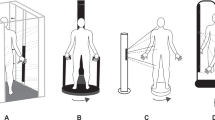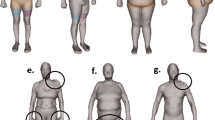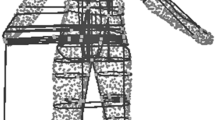Abstract
Background/Objectives:
Anthropometry for measuring body composition, shape, surface area and volume is important for human clinical research and practice. Although training and technical skills are required for traditional tape and caliper anthropometry, a new opportunity exists for automated measurement using newly developed relatively low-cost three-dimensional (3D) imaging devices. The aim of this study was to compare results provided by a Kinect-based device to a traditional laser 3D reference system.
Subjects/Methods:
Measurements made by the evaluated device, a hybrid of commercially purchased hardware (KX-16; TC2, Cary, NC, USA) with our additional added software, were compared with those derived by a high-resolution laser scanner (Vitus Smart XXL; Human Solutions North America, Cary, NC, USA). Both imaging systems were compared with additional linear (stadiometer-derived height) and volumetric (total volume, air-displacement plethysmography) measurements. Subjects (n=101) were healthy children (age ≥5 years) and adults varying in body mass index.
Results:
Representative linear (4), circumferential (6), volumetric (3) and surface area (1) measurements made by the Kinect-based device showed a consistent pattern relative to the laser system: high correlations (R2s= 0.70–0.99, all P<0.001); 1–3% differences for large linear (for example, height, X±s.d., −1.4±0.5%), circumferential (for example, waist circumference, −2.1±1.8%), volume (for example, total body, −0.8±2.2%) and surface area (whole-body, −1.7±2.0%) estimates. By contrast, mean measurement differences were substantially larger for small structures (for example, forearm volume, 31.3±31.4%).
Conclusions:
Low-cost 3D Kinect-based imaging systems have the potential for providing automated accurate anthropometric and related body measurements for relatively large components; further hardware and software developments may be able to improve system small-component resolution.
This is a preview of subscription content, access via your institution
Access options
Subscribe to this journal
Receive 12 print issues and online access
$259.00 per year
only $21.58 per issue
Buy this article
- Purchase on Springer Link
- Instant access to full article PDF
Prices may be subject to local taxes which are calculated during checkout




Similar content being viewed by others
References
Wells JC, Ruto A, Treleaven P . Whole-body three-dimensional photonic scanning: a new technique for obesity research and clinical practice. Int J Obesity 2008; 32: 232–238.
Rahmioglu N, Macgregor S, Drong AW, Hedman AK, Harris HR, Randall JC et al. Genome-wide enrichment analysis between endometriosis and obesity-related traits reveals novel susceptibility loci. Hum Mol Genet 2014; 24: 1185–1199.
Berndt SI, Gustafsson S, Magi R, Ganna A, Wheeler E, Feitosa MF et al. Genome-wide meta-analysis identifies 11 new loci for anthropometric traits and provides insights into genetic architecture. Nat Genet 2013; 45: 501–512.
De Miguel-Etayo P, Mesana MI, Cardon G, De Bourdeaudhuij I, Gozdz M, Socha P et al. Reliability of anthropometric measurements in European preschool children: the ToyBox-study. Obesity Rev 2014; 15: 67–73.
Beleboni MGS . A Brief Overview of Microsoft Kinect and its Applications. University of Southhampton: Southampton, UK, 2015.
Lerch T, MacGillivray M, Domina T . 3D Laser Scanning: A Model of Multidisciplinary Research. JTATM 2007; 5: 1–22.
Tong J, Zhou J, Liu L, Pan Z, Yan H . Scanning 3D full human bodies using Kinects. IEEE Trans Vis Comput Graphics 2012; 18: 643–650.
Daanen HAM, Ter Haar FB . 3D whole body scanners revisited. Displays 2013; 34: 270–275.
Daniell N, Olds T, Tomkinson G . The importance of site location for girth measurements. J Sports Sci 2010; 28: 751–757.
Brooke-Wavell K, Jones PR, West GM . Reliability and repeatability of 3-D body scanner (LASS) measurements compared to anthropometry. Anna Hum Biol 1994; 21: 571–577.
Heymsfield SB, Nunez C, Testolin C, Gallagher D . Anthropometry and methods of body composition measurement for research and field application in the elderly. Eur J Clin Nutr 2000; 54: S26–S32.
MacCormick J . How Does the Kinect Work? 2011. Available from: http://users.dickinson.edu/~jmac/selected-talks/kinect.pdf (accessed 15 July 2014).
Besl P, McKay N . A Method for Registration of 3-D Shapes. IEEE Trans Pattern Anal Mach Intell 1992; 14: 239–256.
Kazhadan M, Bolitho M, Hoppe H . Poisson surface reconstruction. SGP ‘06 Proceedings of the fourth Eurographics symposium on Geometry processing. Eurographics Association Aire-la-Ville: Switzerland, 2006, pp 61–70.
Dijkstra EW . A note on two problems in connexion with graphs. Numerische Mathematik 1959; 1: 269–271.
Hang S . TetGen, a Delaunay-Based Quality Tetrahedral Mesh Generator. ACM Trans Math Software 2015; 41, http://doi.acm.org/10.1145/2629697.
Bretschneider T, Koop U, Schreiner V, Wenck H, Jaspers S . Validation of the body scanner as a measuring tool for a rapid quantification of body shape. Skin Res Technol 2009; 15: 364–369.
Garlie TN, Obusek JP, Corner BD, Zambraski EJ . Comparison of body fat estimates using 3D digital laser scans, direct manual anthropometry, and DXA in men. Am J Hum Biol 2010; 22: 695–701.
Wang J, Gallagher D, Thornton JC, Yu W, Horlick M, Pi-Sunyer FX . Validation of a 3-dimensional photonic scanner for the measurement of body volumes, dimensions, and percentage body fat. Am J Clin Nutr 2006; 83: 809–816.
Li X, Iyengar S . On computing mapping of 3D objects: a survey. ACM Comput Surv 2014; 47, 34:1-:45.
Wei L, Yu W, Li M, Li X . Skull Assembly and Completion using Template-based Surface Matching. Proc International Joint 3DIM/3DPVT Conference: 3D Imaging, Modeling, Processing, Visualization, Transmission (3DIMPVT). 16–19 May 2011, IEEE: Hangzhou, 2011, pp 413–420.
Li X, Yin Z, Wei L, Wan S, Yu W, Li M . Symmetry and template guided skull completion. Comput Graphics 2011; 35: 885–893.
Yin Z, Wei L, Manhein M, Li X . An Automatic Assembly and Completion Framework for Fragmented Skulls. Proceedings of the International Conference on Computer Vision (ICCV). Barcelona, Spain, 2011, pp 2532–2539.
Zhao Y, Li W, Manhein M, Xin L (eds). An automatic assembly and completion framework for fragmented skulls. Computer Vision (ICCV), 2011 IEEE International Conference on; 6-13 Nov 2011.
Moissl UM, Wabel P, Chamney PW, Bosaeus I, Levin NW, Bosy-Westphal A et al. Body fluid volume determination via body composition spectroscopy in health and disease. Physiol Meas 2006; 27: 921–933.
Wilson JP, Mulligan K, Fan B, Sherman JL, Murphy EJ, Tai VW et al. Dual-energy X-ray absorptiometry-based body volume measurement for 4-compartment body composition. Am J Clin Nutr 2012; 95: 25–31.
Aimé Laussedat. 2015. Available from: http://fr.wikipedia.org/wiki/Aim%C3%A9_Laussedat (accessed 12 March 2015).
Jones PR, West GM, Harris DH, Read JB . The Loughborough anthropometric shadow scanner (LASS). Endeavour 1989; 13: 162–168.
Treleaven PWJ . 3D body scanning and healthcare applications. Computer 2007; 40: 28–34.
Acknowledgements
XL and KZ are partly supported by NSF IIS-1320959, NSF IIS-1251095 and NSF ACI-1338051. XL was supported in part by the Baton Rouge General Office of Medical Education.
Author information
Authors and Affiliations
Corresponding author
Ethics declarations
Competing interests
The authors declare no conflict of interest.
Additional information
Supplementary Information accompanies this paper on European Journal of Clinical Nutrition website
Supplementary information
Rights and permissions
About this article
Cite this article
Soileau, L., Bautista, D., Johnson, C. et al. Automated anthropometric phenotyping with novel Kinect-based three-dimensional imaging method: comparison with a reference laser imaging system. Eur J Clin Nutr 70, 475–481 (2016). https://doi.org/10.1038/ejcn.2015.132
Received:
Revised:
Accepted:
Published:
Issue Date:
DOI: https://doi.org/10.1038/ejcn.2015.132
This article is cited by
-
How shape-based anthropometry can complement traditional anthropometric techniques: a cross-sectional study
Scientific Reports (2020)
-
Optical imaging technology for body size and shape analysis: evaluation of a system designed for personal use
European Journal of Clinical Nutrition (2020)
-
A machine learning approach relating 3D body scans to body composition in humans
European Journal of Clinical Nutrition (2019)
-
Revisiting the United States Army body composition standards: a receiver operating characteristic analysis
International Journal of Obesity (2019)
-
The case of GWAS of obesity: does body weight control play by the rules?
International Journal of Obesity (2018)



